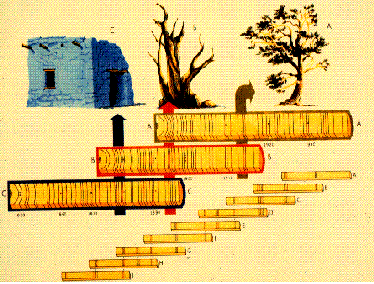Stratigraphy
This is a relative method of dating, based on the principle of superposition, which says that sedimentary layers are deposited over time: when looking at a section of earth those layers on the bottom are oldest, those at the top youngest. Whatever is deposited in the bottom layers is then older than what is found in the upper layers.
At a certain depth these layers should be roughly the same the world over. For example, one division of stratigraphy is magnetostratigraphy, which finds evidence of changes or reversals in the polarity of the Earth's magnetic field; this evidence should be found in the same layers in all regions of the world.
Biostratigraphy studies the various fossils present in rocks, and can take note of things like extinction events.
The branch that specifically deals with time is chronostratigraphy. The upper and lower bounds of a layer are dated, probably by using isotopes, placing it in such and such an age or period.
Seriation
This is another relative method which takes note of trends and changes in the styles of artifacts.
Dendrochronology
This is one of the earliest methods for absolute dating - that is, fixing a more precise age to an object. Dendrochronology uses tree rings to determine age. Every year a tree grows it acquires a new ring, and these rings are wider or narrower depending on the conditions that year (a year with lots of rain will see wider rings, a year with harsh conditions narrow.)
Radiocarbon dating
The isotope Carbon-14 has a half-life of 5720 years, and the measurement of it is reliably accurate up to ten half-lives; so you could determine the age of something up to about 50,000 years. How this is done is explained very well here: carbon-14 dating.
Potassium-Argon dating
Based on similar methods as radiocarbon dating, but instead uses the known rate by which Potassium-40 decays to Argon-40. This method is useful for dating sites between 50,000 and 2 billion years.
For more complete lists of techniques:
http://web.mesacc.edu/dept/d10/asb/archaeology/dating/datingtech.html
http://www.archaeologicalfieldmethods.org/wiki/Dating_Methods_and_What_You_Need_to_Know_Before_Going_Into_the_Field






No comments:
Post a Comment